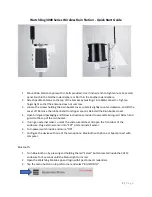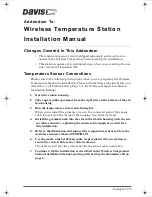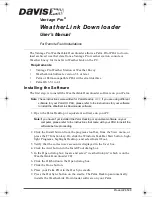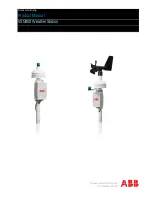
WEATHERPAK
®
TRx
USER’S MANUAL
P/N: 0302-109-011 Rev. B
12
3.2 Using the computer with plume modeling software
With the WEATHERPAK
set-up and operational and the Receiver/Display box connected to your
computer, real-time data is available to run air dispersion plume modeling software.
IMPORTANT NOTE: Some versions of ALOHA (including 5.2.1) need to be upgraded in order to work with a
Station for Atmospheric Measurement (SAM); the WEATHERPAK
is a SAM. The US EPA provides
CAMEO/ALOHA software downloads, support, and information at their website
knowing any changes you encounter.
The following is a brief outline on using the system to produce an ALOHA plume model on a PC
operating Windows 95. There is a general assumption that the user is familiar with ALOHA and that the
program is properly loaded on the user’s computer. Please consult the ALOHA user’s manual for
additional details and program limitations.
1.
Open ALOHA by clicking on its desktop icon, or selecting it from the Programs menu
2.
A series of dialogue boxes will appear including important notes on program limitations.
3.
A Text Summary window will appear with information summarizing the event.
4.
Confirm that your Site Data information is correct. If required, use the SiteData pull-down menu to
change it.
5.
Using the pull-down menu SetUp/Chemical select the chemical (chlorine, for example).
6.
Using the pull-down menu SetUp/Atmospheric/SAM Station a series of dialogue boxes will appear
requiring user observations or assumptions. Relative humidity data is not captured automatically and
can be hand-entered using data from the Receiver/Display box.
7.
Using the pull-down menu SAMOptions select Processed Data. The WEATHERPAK
delivers data
in the proper format for ALOHA to use. A Processed SAM Data window will appear. If the
WEATHERPAK
has been collecting data for less than five minutes a warning message will be
displayed in both the Text Summary and Processed SAM Data windows.
8.
Before allowing selection of the source of the leak (tank, pipe, direct etc.), ALOHA requires the
SAM station to record five minutes worth of data. Using the pull-down menu SetUp/Source select
the source of the leak (tank, for example); a series of dialogue boxes will appear requiring user
observations or assumptions.
9.
Use the Display/Footprint pull-down menu to show the plume footprint. A footprint is required
before plotting the plume onto a street map. Refer to the ALOHA manual for interpretations and
explanations on selecting locations within the plume footprint.
10.
Optional graphs: Use the Display pull-down menu to produce graphs for source strength release rate,
concentration, and dose.
11.
Use the Display/Tile Windows to show multiple windows on the same screen; reposition and re-size
as needed. Display/Stack will organize and stack the windows for quick access.
12.
To plot the plume onto a street map, use the Sharing pull-down menu. As weather conditions change
the plume size and position will change shortly after the WEATHERPAK
provides
updated data.
Note: some software versions require that the ALOHA window overlay the map window in order for
the map-plume to update automatically.







































